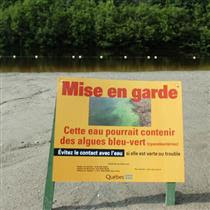Everything you need to know for a dinner-party conversation about ...Blue-green algae
MICHELLE LALONDE, Freelance
Saturday, August 4, 2007
Published: 5 hours ago
Keywords: cyanobacteria, algal blooms, eutrophication, broccoli soup, phosphorus, mises en garde (warnings), avis de non-consommation de l'eau (No-drinking notices), interdiction d'utilisation du plan d'eau (Swimming and boating ban).
So, what's happening? So far this summer, about one-quarter of Quebec's world renowned lakes - we've got about 400 and we love them - have shown up on the Health Department's list of waterways affected by blue-green algae. Cyanobacteria, the scientific term for blue-green algae, are micro-organisms that grow naturally in lakes and rivers. They have been flourishing in the last decade or so, in Quebec and elsewhere, because of a surplus of nutrients, particularly phosphorus, in the water. The algae produce toxins that in certain quantities can make you temporarily sick if you swallow them and can cause a kind of allergic reaction if your skin is exposed to them. Needless to say, toxic algae in the lakes is bad for business in cottage country, and countless tourists and locals have had their summer holidays spoiled because they are afraid to swim or play in the water.
So how many have died? Hang on a second. Nobody has died. And because the symptoms are the kind that could be attributed to other things (knocking back too many mojitos, for example) we don't know how many people, if any, have fallen ill because of the bacteria. Symptoms you might experience after ingesting the toxins produced by cyanobacteria include: stomach pains, vomiting, diarrhea, headaches and fever. If you swim in contaminated water, you might experience skin irritation, eye irritation or sore throat. (There have been reports of animals dying after ingesting the toxin, so keep Fido out of the water if it's green).
But "Fleur d'eau" sounds so pretty. A bloom of algae, or in French, "fleur d'eau," is not a flower, but rather tens of thousands of cyanobacteria cells floating together in water. In great quantities, they turn the water a very remarkable green or turquoise colour. A bloom can look like a green paint spill, or like pea or broccoli soup (not pured soup, but the kind with bits of green vegetables floating in it).
Eutrophi-what? Over thousands of years, a natural process of "eutrophication" happens in lakes and ponds whereby the water becomes overly enriched with nutrients, so plants and organisms like algae thrive and eventually deplete the lake or pond of oxygen. Human activities that generate run-off can greatly accelerate this process, and this is what seems to be happening with Quebec's lakes. Run-off from agricultural fields, lawns, golf courses, domestic sewage and detergents are all sources of the phosphorus and nitrogen that feed the algae.
Government leaps to action. In 2004, the Quebec Health Department started issuing warnings about algal blooms ("algal" is the adjective by the way, so you can annoy your friends by correcting them if they say "algae blooms") in lakes and rivers.
Warnings are a good thing, no? Yes, if they send the right message. Quebec's health department regularly updates four different lists on its website (go to www.msss.gouv.qc.ca and click on the blue-green algae photo). The first includes any lake where algal blooms, localized or generalized, have been reported. There were 90 lakes on that list last week. The second lists lakes and rivers where the algae is thriving throughout. The third list enumerates waterways where the water should not be consumed and/or waterways where recreational activities, like swimming and boating, are banned. And the fourth lists beaches that have been closed because of algal blooms. Only eight lakes were on that third list last week, and two of those had already had their "no-drinking" notices lifted because the water had tested clean. The media has focused on the first list because it includes the most lakes, so it's the most alarming. But most of the lakes on that list are not seriously contaminated. In fact, according to the third list, you could safely swim in all but one of those lakes, without getting sick, as long as you stay away from algal blooms. And who is going to dive into water that looks like green paint or pea soup, or worse, broccoli soup? Beyond warnings. Governments around the world are bringing in measures to reduce the nutrient pollution that makes the algae flourish. Quebec's Environment Minister, Line Beauchamp, said last week she will meet with experts this fall to find solutions. These may include laws targeting farmers, lakeside homeowners and municipalities to reduce run-off and create buffer zones between lakes and sources of pollution. She promised a campaign to correct the impression that Quebec's lakes are contaminated.
Open-ended discussion questions: How is Quebec's love affair with industrial pig farming and waterfront golf courses playing into the blue-green algae problem? If our lakes are going to die anyway in a few thousand years from natural eutrophication, why don't we just sit back, relax and enjoy our pork chops and our golf?
Sources: Quebec Health and Environment Departments (websites and officials),Fisheries and Oceans Canada.
S'abonner à :
Publier des commentaires (Atom)






1 commentaire:
As Quebec is known to have 4% of the world's reserve of fresh water, it would be ashame if we were not able to touch or drink any of it. The situation calls for immediate action from all levels.
Richard
Lac Simon
Publier un commentaire